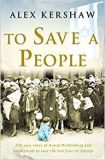To Save a People by Alex Kershaw
| To Save a People by Alex Kershaw | |
|
| |
| Category: History | |
| Reviewer: John Van der Kiste | |
| Summary: An account of one of the most heroic episodes of the Second World War – the operation by Swedish diplomat Raoul Wallenberg to save the Jews in Hungary from Eichmann and the Nazi mission to exterminate them all. | |
| Buy? Yes | Borrow? Yes |
| Pages: 304 | Date: June 2011 |
| Publisher: Arrow Books | |
| External links: Author's website | |
| ISBN: 978-0099539131 | |
|
| |
Raoul Wallenberg, a Swedish diplomat of Jewish ancestry, was without doubt one of the heroes of the Second World War. This book, by one of the war's foremost modern historians, tells the story of his humanitarian work which began with his posting to Budapest in July 1944.
Adolf Eichmann, a senior Nazi officer described as amoral and completely ice-cold in his attitude, had been charged with carrying out 'the final solution', or exterminating all the Jews in Hungary. Deportations from Hungary had begun in May 1944, and within less than two months, an estimated 300,000 Jews had been shot or gassed, their bodies thrown into hastily dug pits, or taken to the ovens at Auschwitz. The descriptions of frightened people knowing they were going to die, being taken away or butchered where they were found, their dead faces frozen in horror, inevitably make harrowing reading. A large number perished at the hands of their own countrymen, a gang of murderous Nazi collaborators called the Arrow Cross, from whom not even young children in homes were safe. On Christmas Eve they entered a Red Cross home and opened fire on several toddlers. It is only fair to note that by this time even some of the relatively hardened SS veterans, as well as the rescuers, were appalled by such incidents as these and by the huge number of dead bodies lying on the main highway from Budapest to the Hungarian border.
Thankfully there is some light relief in the accounts of the lucky few who survived, even if their families were not so fortunate. The 18-year-old Marianne Lowy, an aspiring actress and dancer, who was engaged when Hungary was overrun, escaped with her husband to the United States and at the time of writing is still alive in her late 80s. Her recollections of keeping one step ahead of her would-be annihilators, and those of a few select others, add some immediacy to what could otherwise have been a slightly detached narrative.
Wallenberg hit on the idea of setting up safe houses and issuing forged protective passes which identified Jews as Swedish citizens, in order to save them from extermination. Time was running out, not just because of the Nazi high command's activities, but also as Russian troops, who had little love for Jews either, were preparing to invade Hungary as well. Sweden had remained neutral in the conflict, though there were suspicions that unlike her Scandinavian neighbours the nation was inclined to be more sympathetic to the Axis powers.
There was a happy ending for many, and it is estimated that over a million people around the world are alive today because of the diplomat's efforts. A statistical table gives a full breakdown of approximate numbers liberated and returned from deportation. Yet there would be no reward or similar fitting conclusion to the saga for Wallenberg himself. Early in 1945 he was captured and held in prison by the Russians, who would not believe his protestations that he was the saviour of the Hungarian Jews and were convinced he was a German spy. Two years later, a departing Swedish ambassador to Russia told Stalin that he was personally convinced he had either been killed in a road accident or by bandits. The mystery was never solved, though his mother and stepfather, saying that his fate had lain like a dark cloud over their existence. They considered that the Swedish foreign ministry had washed their hands of him, and until the day they both died (by suicide), they were convinced that he was still alive.
There was however adequate justice for the notorious Eichmann. In one chapter we have an account of his being run to ground in Argentina in 1961, captured and hanged in Israel after being found guilty of war crimes.
In the course of his research Kershaw has talked to some of the survivors concerned, and made extensive use of international archives. Before reading this book, I had only been vaguely aware of Wallenberg and his role, and I found this book extremely enlightening. Ever since the film 'Schindler's List', the name of Oskar Schindler has been synonymous with a similar mission. Let us hope that Kershaw's excellent book helps to make the name of Wallenberg similarly well-known.
Our thanks to Arrow Books for sending a review copy to Bookbag.
If you enjoyed this, for other titles on World War II may we recommend Moscow 1941: A City and Its People at War by Rodric Braithwaite, and Killing Hitler by Roger Moorhouse.
Please share on: ![]() Facebook,
Facebook, ![]() Twitter and
Twitter and
![]() Instagram
Instagram
![]() You can read more book reviews or buy To Save a People by Alex Kershaw at Amazon.co.uk Amazon currently charges £2.99 for standard delivery for orders under £20, over which delivery is free.
You can read more book reviews or buy To Save a People by Alex Kershaw at Amazon.co.uk Amazon currently charges £2.99 for standard delivery for orders under £20, over which delivery is free.
![]() You can read more book reviews or buy To Save a People by Alex Kershaw at Amazon.com.
You can read more book reviews or buy To Save a People by Alex Kershaw at Amazon.com.
Comments
Like to comment on this review?
Just send us an email and we'll put the best up on the site.


